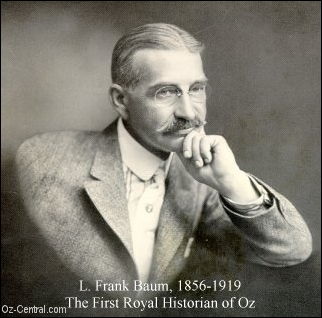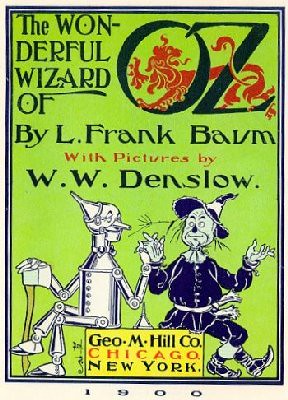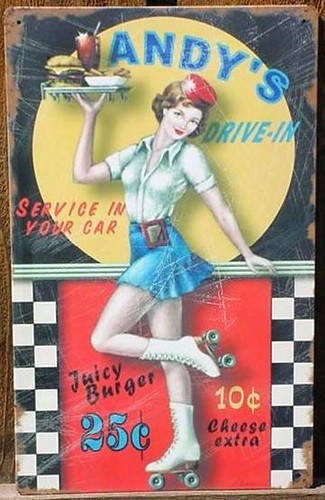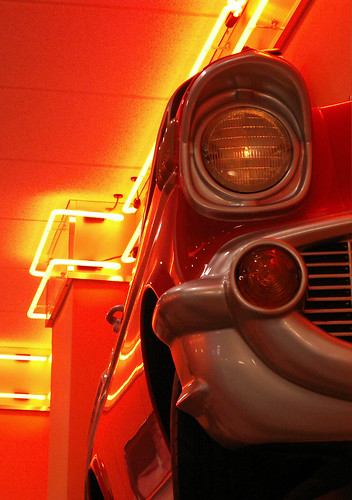The Wizard of Oz

The Wizard of Oz
The Atimic Baum
By: Mike Marino
The Wizard of Oz is a delightful, delirious, damned near psychedelic literary and film romp under the covers. The premise is simple. A gingham clad young farm girl, Dorothy is tornado transported to the magical Land of Oz. Toss in a Wicked Witch and some flying monkeys with bad attitudes and that's entertainment. She hangs out with an oddball assortment of companions she picks up along the way like wayward hitchhikers and they venture forth in search of the Emerald City, considered to be the Las Vegas in the Land of Oz. Here they hope to find the wizard who, rumor has it, can give her posse a heart, courage and a brain. Dorothy just wants to go back home to the dust bowl with her little dog Toto too and following one harrowing adventure after another, including murder of a witch, clicks the heels on her ruby red slippers and chants the mantra "There's no place like home. There's no place like home." Even if it is Kansas!
Created by L Frank Baum this was the Easy Rider of fantastic fantasy characters that has a rich history in print, the stage and on the silver screen. Written over 100 years ago, is as timeless and ageless as Dick Clark used to be. To begin our story of just how the Wizard of Oz became one of the top pop culture wonders of the world we have to follow the Yellow Brick Road of history, back to the year 1856. Once upon a time.....
The Baum matrimonial garden had been planted and from it sprang a son, L. Frank Baum, who was born just over the rainbow north of Syracuse, New York in 1856. An inquisitive child, he began exploring the worlds of literature and theater in his early teen years. Before Baum reached the age of twenty, his father had purchased a portable printing press for him and the young entrepreneur published a small local read all about it newspaper along with his own magazine. The printers ink ran side by side with the greasepaint in Baum's veins and in 1881 he wrote, produced and staged a lavish musical theatrical production replete with big belting show tunes with all the Ethel Merman in him he could muster. To the young Baum, there was no business, like show business.
>
The hunchback cupid of Notre Dame rang wedding bells as Baum found true love and married Maude Gage in 1882 and this led to a proliferating of little Baum's to carry on the family name. Eastern society was smothering the adventurous Baum which led him to pack up the family and follow the advice and compass direction of one, Horace Greeley who said, "Go west young man, go west." The wild and wooly Dakota Territory was wild west wide open and the Baum's arrived in Aberdeen, South Dakota where he opened a frontier mercantile store called Baum's Bazaar to cater to the needs of cowboy and settler alike. He even began a small local newspaper again to feed his journalistic addiction but by 1891 both Baum ventures bombed and knowing when to fold his cards packed the clan up once more and this time headed back east to the Windy City of Chicago where he kept afloat as a reporter for a newspaper and eventually went on the road as a traveling salesmen.
He roamed the Midwest like a buffalo on the prairie and while other salesmen spent large amounts of time in saloons regaling each other with tasteless jokes about finding heaven in a haystack with a hayseed "farmers daughter", Baum spent time developing stories in his head to tell his children at bedtime. Baum's vivid imagination tossed a fragmentation grenade into the mystical lands he created in his mind and the explosion created a bomb crater of creatures who managed to crawl to freedom and safety in the hearts and souls of children for over 100 years.
Baum's first published work was 'Mother Goose in Prose" published in 1897, followed by the equally successful "Father Goose, His Book." In Mother Goose, Baum introduces a young girl named Dorothy, (yes, a farmers daughter!) in the last chapter. She was destined for literary and celluloid fame in black and white as well as technicolor, for time immemorial. Two years later on the precipice of the end of the 19th Century, Baum teamed up with illustrator W.W. Denslow to produce the follow up to Mother Goose, called "Father Goose, His Book" in 1899. It became a runaway bestseller, raging across the country like an out of control wildfire on the Kansas prairie. Now that he was established, the stage was set, the literary planets in alignment and the fantasy storm clouds were gathering strength and ready to unleash a literary super-cell in the tornado alley of pop culture.

The year 1900 saw the release of the Baum/Denslow fantasy phenomenon, "The Wonderful Wizard of Oz" It rode a tsunami crest of popularity and provided economic prosperity to Baum along with fame and the fortune that goes with it. In 1902 he decided to marry his two interests of literature and theater by writing and producing a traveling theatrical roadshow of "Wizard' that not only gave it's regards to Broadway, but toured the country until 1911. Baum also wrote the first of 13 Oz sequels and in 1904 published ""The Marvelous Land of Oz." The Oz cash cow was being milked for all it was worth and by 1910 the family Baum said "Hooray for Hollywood" and moved to the fledgling movie making town where fantasy becomes reality on the silver screen. Their home was named, appropriately, Ozcot and by 1914 it was "lights, cameras, action" as Baum donned a directors megaphone and formed the Oz Film Manufacturing Co. on property next to Universal Studios, the same people who brought Frankenstein to life along with reviving the legend of Dracula. The Oddballs of Oz were about to come alive themselves for the first time on film.
The silent movie era was in full swing and Oz Films first release was a curious piece called "The Patchwork Girl of Oz" with a male cast kabuki like in the lead role whose character resembled a drag queen quilt looking for a bedspread. Very cabaret for the times. George Lucas technology was was still light years off and in a movie galaxy far, far, away so the animal characters, including a bizarre boxlike barnyard semi-bovine called a Woozy, were presented in full costume rental shop regalia without shame or guilt pre-dating Ed Wood schmaltz by half a century!

This masterpiece of cheese was followed by "His Majesty, The Scarecrow of Oz" and the "Magic Cloak of Oz." .Baum was on a roll of film reel releases and in 1915 released "The Witch Queen" and "The New Wizard of Oz." The New Wizard was really no more than a reconstituted remake of "His Majesty, The Scarecrow of Oz." Confused yet? There was a British release as well as the Redcoats discovered Oz. Oz Films finally clicked it's ruby reds and called it quits after just a couple of years and it seemed as though the Yellow Brick Road was closed for repairs.
Frank Baum died in 1919, and the final Oz sequel, "Glinda of Oz" was published one year later. Dead men tell no tales, but in Baum's case, the Oz beat goes on. "The Wizard of Oz" was released in 1925 and was the first non-Baum film of Oz. It was presented as a slapstick screen comedy with plenty of vaudevillian schtick. All it was missing was Larry, Moe and Curly in key roles. The weirdity of this version was the casting of Oliver Hardy, sans Stan Laurel, as the Tin Man who actually morphs into an evil heavy metal entity hellbent on killing! All they were missing was the Little Rascals as the Munchkins and the Keystone Cops. Frank Baum, Jr. was involved in the screenplay so the Baum hand print was on this version. In 1931, "The Scarecrow of Oz" was remade and released and a technicolor cartoon called "The Wizard of Oz" was released in 1933 again with Frank Baum, Jr.s hand at the screenplay helm.
Storm Trooper storm clouds were brewing in Europe in 1939 as the Wicked Witch of Nazi Germany got ready to plunge the real world into a murderous reality. It was also the same year that Warner Bros. split the pop culture atom with the release of "The Wizard of Oz" with Judy Garland. This version is still The Atomic Baum of all Oz films.
This technicolor masterpiece is a tornadic fantasy garden of Judy Garland and a prismatic kaleidoscope of colorful creatures, big and small, bad and good. It's a horn of plenty of manic munchkins, a cowardly king of the jungle, a heartless heavy metal man of tin and a brainless cornfield scarecrow. Dorothy and Co. manage to fend off legions of flying monkeys and a whacked out witch seeking revenge. In one sequence it's as though they all stepped through the looking glass and walked into Haight Ashbury as they all succumb to an opiates sleep in a field of questionable flowers.
It all started during a twister when Dorothy and her little dog, Toto, were swept up, up and away in a b&w Dustbowl Kansas tornado and crash land in living color on top of a witch, killing her instantly, proving that people don't kill people, farmhouses do. Seems the deceased had a sister witch who vowed retribution on Dorothy but with a little help from her friend, the good witch, Dorothy dons the magic ruby red slippers worn by her now dead victim. These would not only protect her from a wicked witch magic spell mugging but also make a fashion statement that even Elton John would salivate over. Now it is time to for the gang to get their kicks on the Route 66 of Oz, The Yellow Brick Road, and it's off to see the Wizard, the Wonderful Wizard of Oz. Rumor has it the Wizard can get Dorothy and Toto back home to their rectangular state and a brain, courage and a heart for her three amigos at the same time.
Ok, so it was all just a damned Dorothy dream anyway...the film was boffo at the box office and in Hollywood, that is all that counts.
Oz pop culture went on hiatus until 1975 when a new musical version with an African American slant hit the great white way of Broadway and the Emerald City was now Harlem. The film version of this production hit the screens in 1978 which was followed by a Disney production in 1985 and in time a new Broadway show called "Wicked".as a toast to the literary wizardry of L. Frank Baum. DVD's, Video's, You Tube and a myriad of digital sources keep Dorothy and her gang forever young and forever in our hearts. There's even a Wizard of Oz Museum in Liberal, Kansas and a Toto Festival in Iowa. Yeah, Iowa! Go figure.
So close your eyes, click your heels and transport yourself back to a time of wondrous childhood imagination and fantasy. If you look carefully you can see it now, just over the rainbow. Just hang a left at the Yellow Brick Road.


Fifties & Sixties Pop Culture! Classic Cars, Rock n' Roll, Elvis, Route 66, Drive in Movies, Route 66, Roadside Culture, Kerouac & The Beats, Haight Ashbury, Easy Rider & Vietnam

Available in US, Canada, UK, Australia, Germany, France, Netherlands & Japan

BBQH BABY BOOMERS HEADQUARTERS MAGAZINE
This is the epitome of a boomer roadie book for the boomer roadie. It's funny, it's nostalgic, it's interesting. Route 66, fins, fuzzy dice, carhops. It's all there. This would be a great gift for the roadhead in your life.
